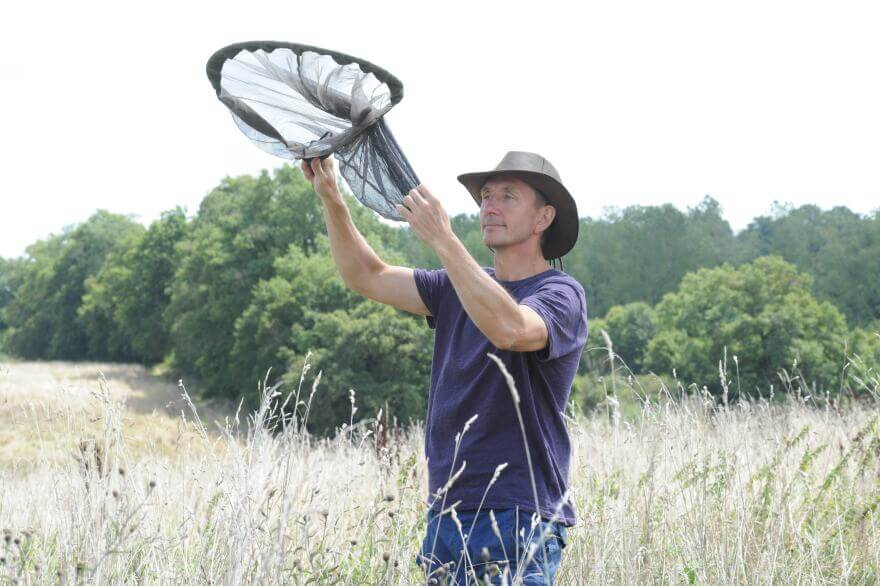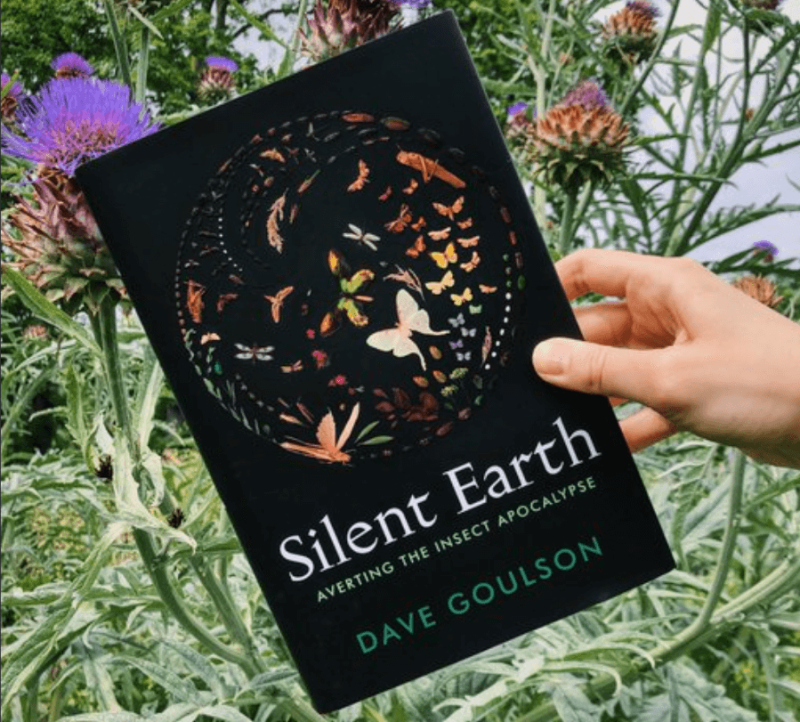If you keep up with the news in the mainstream media, you might think it’s time to ditch the flyswatter and trash the bug spray: In the finest tradition of yellow journalism, the New York Times declared, “The Insect Apocalypse Is Here,” warning that if we lose insects, our entire ecosystem and food supply will collapse.
The apocalyptic rhetoric stokes fear, and also creates distrust. Trust in journalists has plummeted to all-time lows, and trust in scientists is becoming highly polarized as well, as science increasingly is seen as advancing a particular political or policy agenda, rather than being a dispassionate search for truth. Public skepticism is further deepened as one controversial issue after another – for example, climate change and the “bee-pocalypse” — is presented as an existential threat to life on Earth, despite clear problems with supporting evidence.
A new book by controversial biologist Dave Goulson, “Silent Earth: Averting the Insect Apocalypse,” is a case in point. No stranger to hyperbole, he posits that humanity’s “chemical onslaught on nature” is “akin to genocide,” and the “fragile web of life on our planet is beginning to tear apart.”

In the law, there’s a saying, “Extraordinary claims demand extraordinary evidence.” However, much of Goulson’s evidence is purely anecdotal — such as fewer bugs splattering on the windshields of European cars now compared to the past — and the few studies of global insect populations he does consider are deeply flawed or mischaracterized in his account.
Perhaps the most problematic study of them all is the one that precipitated the insect apocalypse frenzy — a 2017 study co-authored by Goulson with 11 other scientists that compared insect populations in certain German nature reserves over the last quarter century. Its dramatic finding — that the biomass of flying insects had declined an astonishing 76 percent in 27 years — together with Goulson’s eager goosing of the press — generated the apocalyptic headlines he was clearly seeking. Nature magazine’s headline, “Flying Insects are Disappearing from German Skies,” at least specified the location of the study’s findings, limiting the claims somewhat. But others simply presented the effect as universal. The Guardian actually quoted Goulson in its headline: “Warning of ‘ecological Armageddon’ after dramatic plunge in insect numbers.”
Experts who raised doubts about the study received little attention, but there was much to criticize. Among other things, the researchers in many cases failed to sample the same sites in comparison years — a fundamental flaw that in itself renders the findings suspect, if not totally meaningless. They also used what are called malaise traps to collect their samples. These only collect insects when they are flying, which is highly influenced by other variables like the weather — insects fly more when it is warmer — making the measurements even less reliable, despite the scientists’ attempt to account for them. And even though the study took place in nature reserves and did not even purport to test possible causes of decline, Goulson was immediately giving interviews to the press blaming agricultural pesticides (a long time hobby-horse of his), in the absence of any evidence in the study to support the claim.
Of course, even if one were to overlook these flaws, extrapolating from a few German nature reserves to claim a global “ecological Armageddon” was a stretch. Germany is one of the most highly developed and densely populated places on Earth. It has been undergoing major land use changes for centuries, including the construction of some 30,000 wind turbines — whose massive blades are known killers of flying insects — and likely huge increases in light pollution (it isn’t just moths that are attracted to bright light). That’s why, to make the claim of global effects stick, Goulson relied heavily on a 2019 “meta-study” by Francisco Sánchez-Bayo and Kris Wyckhuys to support his claims of a global decline, Unfortunately for him, that study is even worse than his own and was widely criticized by the scientific community for its transparent bias — the authors only included studies found with a keyword search of “decline,” automatically excluding studies showing stable or rising populations — and numerous other flaws..
Goulson also cites a much better, though still highly imperfect, meta-analysis of global insect populations led by ecologist Roel van Klink that was published last year — except that Goulson omitted findings that contradicted key claims made in “Silent Earth.” Most notably, Van Klink’s study undermined Goulson’s assertion that insect declines are particularly severe in North America, and that modern agriculture — particularly pesticides — is the major culprit. Van Klink found, in fact, that as of the year 2000, insect populations were no longer declining in North America and that cropland was actually correlated with increasedinsect populations. The only correlation van Klink could find with insect declines was land use changes and habitat destruction due to urbanization, which is hardly a startling revelation.
Van Klink did purport to find global insect declines, but these were three-to-six-fold smaller than the catastrophic claims made by Sánchez-Bayo and Wyckhuys and Goulson. Arguably the weakest aspect of the Van Klink et al study was the attempt to model global trends from the sparse and woefully incomplete data that exist on insects in most parts of the world.
As shown on the map below, the great majority of the studies reviewed came from Europe and North America. Very few studies looked at insects in the entire, vast landmass of Asia, the largest continent in the world, or Africa, the second largest, or Australia. Hardly any studies included the insect-rich equatorial regions, and only one from the Amazon, which is thought to be home to between two and three million different species of insects, most of which haven’t even been named or characterized yet.

Goulson, who clearly is aware of the flimsy factual basis for his apocalyptic claims, occasionally tosses in a qualifier — e.g., a phrase such as “the declines, if they are real” (emphasis added) — in an attempt to inoculate himself from criticism. Well, sure. As the saying goes, “If wishes were fishes, we’d all have a fry.”
More troubling, he fails to inform his readers of critical data that completely undercut his thesis, the most compelling of which is a study published last year by biologist Matthew Moran and a team of 11 researchers examining insect population trends in the United States. They analyzed insect diversity and abundance records at sites with varying climates across the United States over nearly four decades and found no overall decline. None. Some groups of insects in some areas declined while others increased. Altogether, insect populations in the US are stable and have been for decades.
This isn’t Goulson’s first rodeo. Once an obscure butterfly scientist, Goulson rose to international prominence as a leader of the successful crusade in Europe to ban a class of state-of-the-art insecticides called neonicotinoids (neonics for short), which environmentalists blamed for causing catastrophic declines in honeybee populations. At the time, the putative crisis — widely referred to as the “bee-pocalypse” — was headlined around the world, with literally thousands of stories predicting the imminent demise of the world’s honeybees and warning in terms very similar to today’s Insect Apocalypse stories of collapsing food supplies and global starvation.
But there was no bee-pocalypse. The whole time, honeybee populations were actually increasing — in Europe, North America, and in fact every habitable continent on the planet — and, importantly, they had been increasing ever since neonicotinoid pesticides entered the market in the mid-1990s.
By the time that was widely recognized, however, the EU had already banned them, and as much as any other individual, Goulson deserves credit — or blame, depending on your point of view — for that. What can hardly anyone could chalk up in the “credit” column was how Goulson and others misused their position as scientists to manipulate the political and regulatory process in the EU and mislead the public. (Moreover, because neonics could be applied as seed coatings instead of foliar spraying, they had significant environmental and occupational health advantages over older pesticides.)
The affair, which came to be known as BeeGate, was chronicled in the London Times in an article titled, “Scientists accused of plotting to get pesticides banned.” It reported on a leaked strategy document by members of the International Union for Conservation of Nature (IUCN) Task Force on Systemic Pesticides outlining their plan to have selected scientists conduct studies – with predetermined conclusions that would demonstrate that neonics are harmful to bees — that would appear in a “high impact” publication and provide a “stronger scientific basis” for a campaign to ban the products.
Goulson was a leading author of the “high-impact” paper that resulted, which was instrumental in solidifying the political pressure to make the EU’s 2013 “temporary” ban on neonics permanent. He is the epitome of what David Zaruk, the risk and science communications analyst who first broke the scandal, describes as an “activist scientist,” i.e., someone who apparently sees nothing wrong with researchers pre-determining the results of their studies to fit a political agenda. Subsequent to the IUCN scandal, Goulson has continued to produce studies that to all appearances have been made to order for activist clients such as Greenpeace and 38 Degrees.
This sort of shadiness pervades Goulson’s book, such as when he recommends that readers who want authoritative information on pesticides refer to the notoriously biased, mendacious Pesticide Action Network, without disclosing that he is a Trustee.
Scientists sow public confusion and mistrust when they forsake science to pursue parochial policy goals. Dave Goulson is one of them.
Henry I. Miller, a physician and molecular biologist, is a senior fellow at the Pacific Research Institute. He was the founding director of the FDA’s Office of Biotechnology. Find Henry on Twitter @henryimiller
































